The Band That Never Was -
X and the Mermaid '69
by Martin Pincher
Originally published in DeTox Magazine
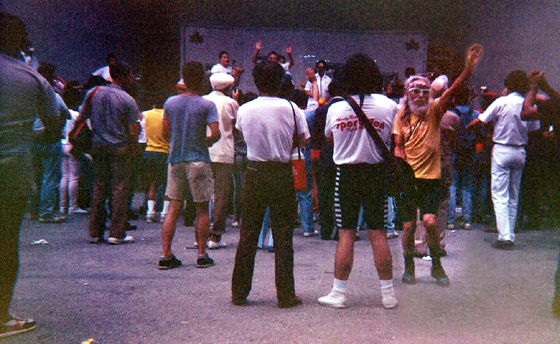
|
| Tompkins Square Park bandshell |
In the mid-eighties, New York City was a hot-bed of musicians, both established and wannabes. Of course, that could be said about New York in any time period during the 20th century, but it was particularly true for the East Village in those days. A walk across Tompkins Square Park exposed a body to a rash of guitar-clasping, leather-clad-in-summer, Lou Reed-hopefuls. Or you might bump into Brian Eno buying cat food at the all-night pet store on Eighth Street. Among the failures dotting the band scene was X (for Christ) & the Mermaid '69. They did a lot of recording, but never got a contract. They did a handful of shows that were more performance art than rock n roll. They got some radio play, but few knew them. When they broke up they left nary a ripple in New York and, in the spirit of the times, they didn't seem to care. Each member had other things going on and drifted out of the City on different tides. Still, the music was interesting, which is how other artists describe work that they can't really like. Whatever one thinks of of the music, it sounded like no one else.
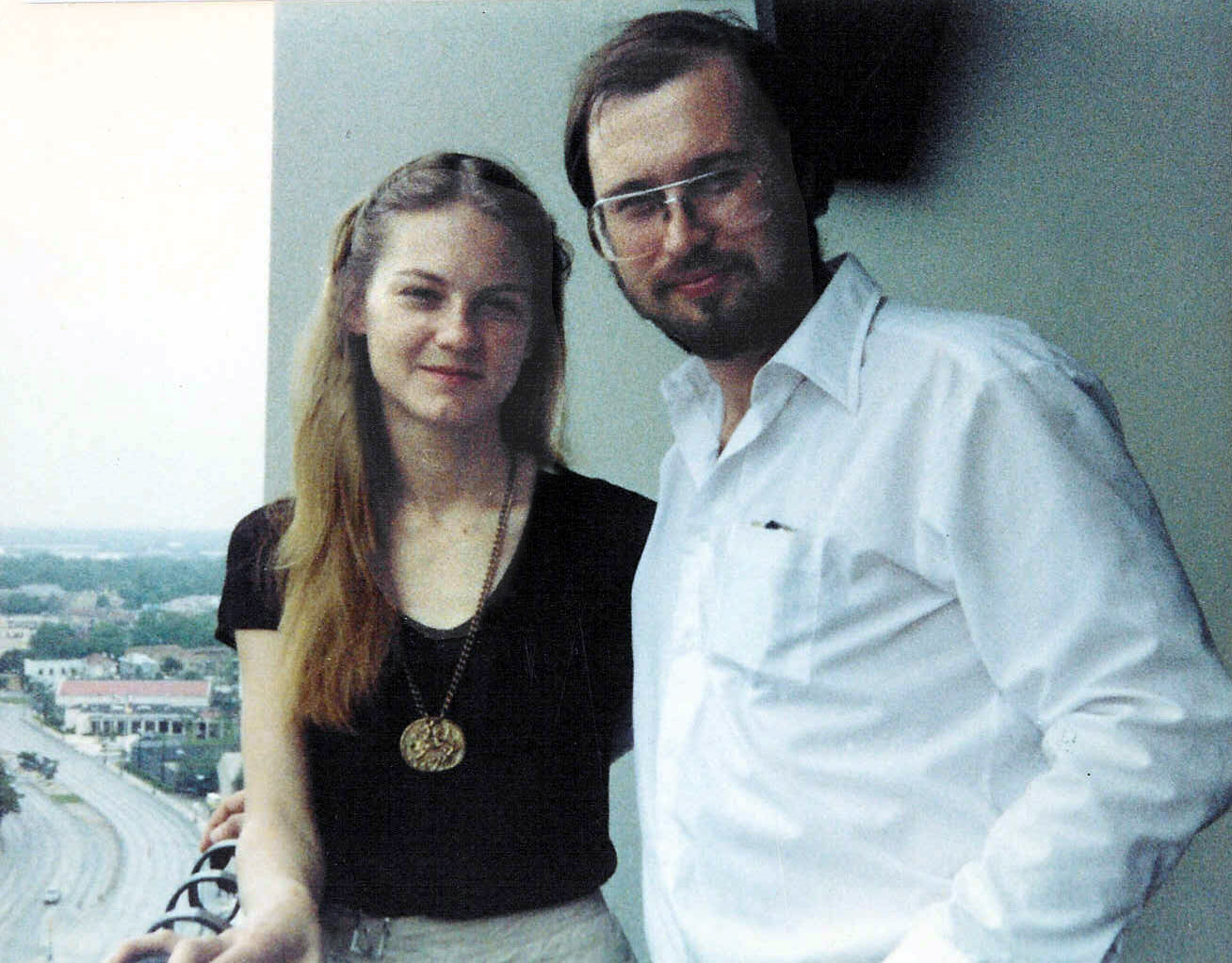
|
| That 70's couple - Alan and Mary in San Antonio |
The core members of Mermaid were Mary Hestand, Susan Norman and Alan Tubbs. The girls were from Irving, home to the Cowboy's Texas Stadium. They were both into drama at Irving High and ended up at Trinity University in San Antonio, which in the '70s had a well-respected drama department. The English department also had a good rep, which brought Alan. Alan did some sound design for Mary's plays and got her to perform "Cassandra Prophetess," one of his poems, to his electronic music. Then he redid the sound and got Susan to perform it. Despite Alan's seemingly suicidal tendency of replacing one blond actress with another, he and Mary continued working after graduating from Trinity. They ended up together in Dallas, along with a mutual friend, Cheryl Dyer. Cheryl spent a lot of time recording audio off the TV the summer that Anwar Sadat was assassinated. Alan recalled that "She got a lot of great stuff. The best was Walter Conkrite claiming, 'We don't know anything, and nobody here seems to know anything.' She made a lot of loops that I used to break up the poetry that added a whole other texture to the pieces." That kind of sampling, so de rigueur by the end of the decade, was cutting edge in 1980. It was all done on audio tape; video was still a few years away from being available outside of television studios.

|
| Chery Dyer - always a cut-up. |
The music, or soundtrack, was produced on a Mini-Moog, an Arp Odyssey (the two must-have analog synthesizers of the 1970s) and an Echo-Plex onto a Teac ¼ inch 4-track reel-to-reel running at 7 ½ ips. The mike was the cheapest Sony back-electric condenser available. This was hardly professional, but a precursor of the home studio that would become popular in the coming decades. Alan didn't operate under a band name or even his own. He had produced half-a-dozen 40 minute long tapes during the last half of his college days and the stint in Dallas. Probably the best piece done during those years was the above mentioned "Cassandra Prophetess." A bed of cacophonous electronic sounds had, layered over the top, some of his spoken poetry. He had a nasal quality to his voice that didn't necessarily add to the performance, which is one reason the more professional performance by both Mary and Susan added to Cassandra. Several other guests had appeared on his tapes, most notably Gibby Haynes and Paul Leary of future fame with the Butthole Surfers. "I got probably their first performances on tape, that is, before they were the Surfers. I don't even remember what Gibby did, but I have him credited on the back of the tape box. And I have an appalling thing Paul did on a $10 Sears guitar we had around the apartment. I recorded it at half speed so when we played it back it sounded like a one-set-of-grandparents mandolin. And we were saying 'Check it out' over and over at different speeds. Just last year I threatened to blackmail him with its release and he said it might be the best thing he ever did." But Cassandra was the only piece that had someone else performing Alan's poetry. So the bits liberated (his term) from TV took the spoken component of the music to a different level.
Within two years, Mary and Alan had moved to New York for graduate school. Mary was attending Columbia's theater school and found a place uptown, which she shared with Madonna. "I still have a pair of her jeans. If I only had a way to prove they were her's. Still, I felt lucky, I was the only one in the place that she didnt rip off. She even sold the landlord's furniture to the girl that moved in after her." Alan found a place in Brooklyn where he could set up his studio. The City was trying to renew the area and had forced out all the renters, but several businesses hired lawyers and stayed. Accardi Hardware kept getting burglarized, so Dave Accardi rented out the second floor for $50 a month as a security system. There Alan completed his best electronic poem. It was another 40 minute piece (the length that a reel of tape would last at 7 ½ ips). "'The Society for the Suppression of Savage Customs' had some good poems on it but the main thing was the music. It was mostly the Arp with a sample and hold rhythm going on. I've got a cassette that I still play in the car and it doesn't make me wince. Long pieces of it just seem to flow and there is a lyricism you don't get, or at least I had never gotten before, with electronic music. Of course, right after that I got the Siel and started doing real, quote unquote, music."
The Siel was Alan's first instrument since a high school Hammond organ that could play more than one voice at a time. And it could only play six. "I had some cash from a student loan and wanted a new keyboard. I almost bought a Synthi, the old suitcase analog with a patchbay and pushpins. The Trinity electronic music room had one and I loved it. But I ended up with the Siel. This was in '83 and the DX-7 was out, but the Siel I could understand. It had all the knobs on top instead of a little slider and sounded pretty good. After I bought it I started doing some songs with another writer, a guy from Chicago, Ken Saunders. He taught me some chords and progressions over the course of a few songs. They are absolutely dreadful, real garage type stuff only done on the synth. I came up with a little riff for one and then Mary and I did a different song off it. She still hates it. She tried to do a Laurie Anderson. The lyrics are funny and the production is awful, but it was the first Mermaid song, even though we didn't have the name then. I re-learned the riff last year and need to do a third version of the song."
"X-mas 1984" had the elements of a lot of Mermaid songs -- a single riff running endlessly through the song, Mary's vocals and monochromatic lead and a host of electronic sounds popping in and out. Mary remembers reading that one of the members of Devo said he had to learn not to play so many notes. "I wouldn't have had to learn that at all. I would have been a perfect fit." Unlike Alan, she had taken piano and played French horn in high school, so the basics of music theory weren't a mystery to her. As Alan said, "All the music theory and lingo is foreign to me -- chorus, bridge, chord progression, etc. I see song structure more as applied mathematics. I'll bang away on the keys until I come up with a series of notes or chords I like. Then figure out how many times I have to loop the performance to make it work out into a song. And half the time the riff is very sound specific. The sound interacts with the rhythm and if you use a different sound, it isn't nearly as good. I had a couple of variations on the Siel I used a lot for the psycho-pop stuff we did. One was the pre-set strings that came with it -- very ballsy analog sound. Tweak the knobs a little bit and you're off. The other is a take off of the jazz organ preset, which I made sound more like a calliope. Though it doesn't really sound like a calliope anymore than the strings sounded like real strings."

|
| The Mermaid's view from Brooklyn (if the windows hadn't been cinderblocked over) |
The Brooklyn days also brought a lot of out of town visitors. Alan remembers that, "My mother almost cried when she saw the place. We had to walk half a mile from the subway and once you crossed the BQE (Brooklyn Queens Expressway) it looked like Berlin after WWII. The firemen knew all the local streetpeople; they were down there so much because the squatters would catch the empty buildings on fire trying to stay warm. Many friends from Texas that needed a place to stay while they looked for their own place to live camped out on the floor or in the spare room." (Some things in New York never change - Ed.). Susan, who had been doing a dinner theater tour for a year, visited. Then there were the Butthole Surfers. They were an indie band before there was such a term. They lived out of their car and wandered from city to city like medieval troubadours, finding old or new friends to stay with. Their live shows were a windfall and enabled the Surfers to restock their supply of consumables, eat out at least once and maybe buy a carton of cigarettes to pay back their hosts. Mary remembers waking up to head into the city for class, the 5 mummies in their sleeping bags spread out lengthwise across two rooms of the apartment so you had to step over them to get out. "God, one time they must have spent a month camped out in our living room. With all their equipment too. They used our place as a rehearsal studio. One night, or maybe morning, when they took a break, we heard all this yelling downstairs. It was the bums, and they had brought a policewoman to complain about the noise. It still cracks me up, getting complaints from the winos and junkies that lived in the abandoned buildings on the waterfront. After that, the Buttholes went to stay with Cheryl (Dyer, who had also moved to NYC -Ed.). I don't know how they lived that way for so many years."
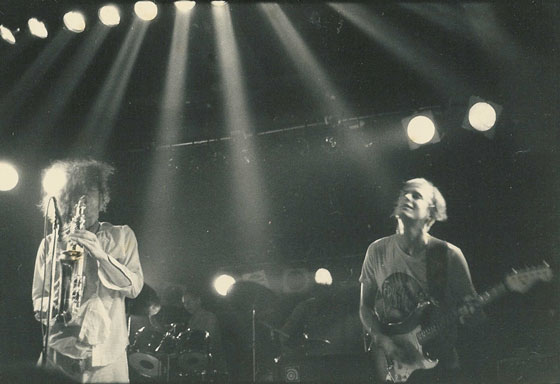
|
| Gibby and Paul ~ 1984 |
Sue recalls staying at Mary and Al's place in Brooklyn at the same time as the Surfers - "Paul was a great showman, and always going for the shock value.
When we were living together in San Antonio, he'd come back from a tour with a pink mohawk or his head shaved up like a lab rat, and enjoy watching my mouth drop.
When our tours collided in NYC, I persuaded him to let me give him a hairstyle that no one else would be wearing at Danceteria that night.
He let me curl and tease his hair into a lovely up-swept doo, reminiscent of George Washington a la 1776.
Complete with a double-breasted blue wool jacket, Paul was all ready to cross the Potomac (or the East River) and take the city by storm. I don't think he was proud, but he wore it like a man."
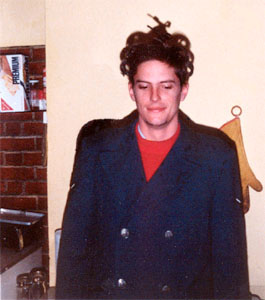
|
| Paul Leary primping in Al's apartment |
A little later Gibby was back in New York, solo, to buy some recording equipment. By this time Alan had upgraded his reel-to-reel to a Tascam 38, the dernier cri of the project studio at that time. It ran ½ inch tape at 15 ips and was considered semi-pro, but a lot of albums still got produced using one. Alan recorded one of Gibby's songs that the Surfers would later put out on the Texas band compilation "All Gods Dogs." "'The Legless Eye of Eindhoven' is the only thing I ever had released on a label. Gibby used the Siel and a bass for most of it, and banged the keyboard so hard the spring reverb I had sitting on the stand rattled with explosions. And I had this circa 1950s percolator for coffee that made Darth Vader breathing sounds. We used that and recorded it with echo. I even played cymbal on a track."
Shortly afterwards the City forced Alan and Mary to move. "You can see that apartment on the hour-long 'Miami Vice' episode where Crockett and Tubbs (no relation) go to bust heads in the Big Apple. It's the stash house that gets blown up." Alan moved the studio to Bond Street, where X & the Mermaid were born. Susan had moved to New York to attend the graduate acting program at New York University and she started working with Alan and Mary. Alan, "We ended up doing two types of songs. Psycho-pop and heroin dance music. For the psycho-pop stuff I would play the main riff on the calliope, pan it off to one side, and do a variation, either bass or a right hand chord stab, and pan it off to the other side. That would become the basic rhythm track. I got a Yamaha drum machine so that I could combine my feeble attempts at programming with some of their professional drum patterns, which forced me play the keyboards a lot tighter. Sequencing with a computer didn't come along for a while after that, so the keyboards had to be played live. The heroin dance stuff was slower and more electronic and usually had more audio clips."
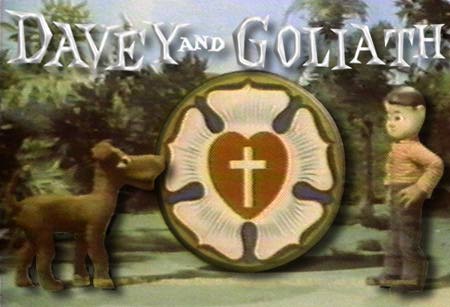
|
| Davey and Goliath Logo |
Susan's first song with the soon-to-be-named Mermaids was "Yielded and Still." Chuck Crook was Alan's room mate and he did underground after-hours parties in various New York venues. Alan started doing the sound for these and they went on until dawn. By this time Alan had a Beta VCR and started taping the old "Davey and Goliath" claymation series by Art Clokey (also of "Gumby" fame) on those early Sunday mornings. The main rhythm in "Yielded and Still" is an ominous church-like organ. The songs intro, however, is a cheesy Casio rendition of the old Lutheran hymn, "A Mighty Fortress is Our God," which began each episode of the "Davey and Goliath" show. Mary and Susan sang the hymn lyrics while Alan laid in audio clips from the series. Susan did vocal warm-ups before singing, and Alan got her to do that throughout the song. The whole effect is funny yet disturbing. "Sampling had just started happening but I didnt have a sampler. So I would just drop in the audio from the VCR. I got Davey's Dad to say 'Keep cheating, keep lying,' over and over. There are a couple of the old songs I need to redo. I was still learning engineering and arranging at that point, so they really aren't up to snuff production wise. But I should have gotten a producer credit from the Surfers about then. They were in town mastering the "Rembrandt Pussyhorse" album and had two versions of "American Woman;" a straight rock 'n roll version and one that their engineer had cut up. They were trying to figure out which version to use, and I suggested both. Start the album with one and end with the other. Nobody really said anything so I was surprised when it came out that way."
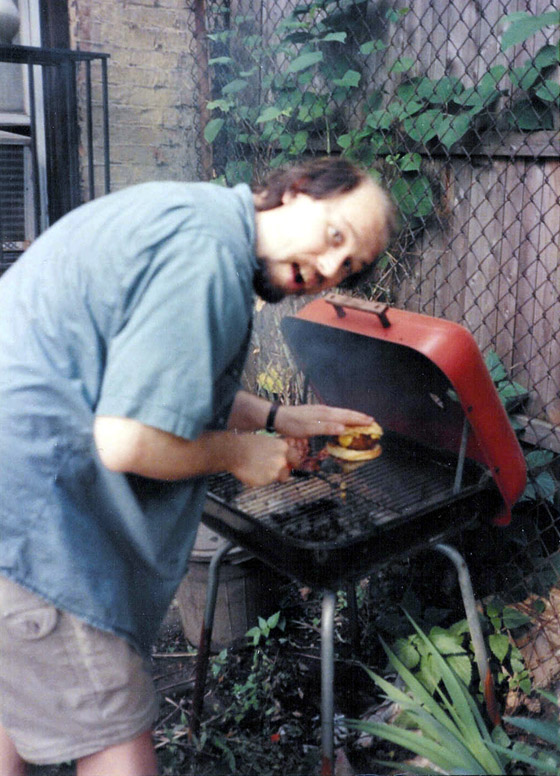
|
| Alan prepares dinner for the multitudes |
A little over a year later, Alan moved himself and the studio to East 8th Street when he and Chuck lost their sublet on Bond. Mary was living on Greenwich Street and Susan was in Brooklyn. By this time, Mary was working for the Wooster Group with the likes of Willem Dafoe and Spalding Gray doing experimental theater. She did grunt work for the Group so she could hang around their rehearsals. Susan was finishing up at NYU, working with Marcia Gaye Harden. As Mary said, "We had so much going on. Everybody had a least a couple of projects at any one time and we still had to make a living. Alan was always trying to get us to come over and finish some song he was working on. He'd bribe us with dinner. He had the ground floor and so he could barbecue. You couldn't get any decent Mexican food in NYC (you still can't - Ed.) so he'd make fajitas. And once he'd invited one of us, everyone would show up. The Texas gang, anyway. Susan was still rooming with Steve and Doug Smith and Diana Lamar. They were all from Trinity. It was surprising we got anything done with such a crowd around."
Not only was Mary working with the Wooster Group (she performed in their piece "Frank Dell's the Temptation of St. Anthony"), she had gotten hold of an old 8mm camera and started making movies. Her first was "Magical Thinking," and it included a lot of Mermaid music. One of the songs she used, "Marshmallow-man Dance," is one of Alan's favorites. "That is one of the better psycho-pop songs. We really nailed it. I had written a fairy-tale type poem, all opposites, for Alan Ginsberg's class. He was teaching the grad poetry class at Brooklyn College, and I used to give him a ride out there for the Monday classes. He lived just up on 12th Street. I am still the only person I know that didn't have enough sense not to have a car in the City. Anyway, the Gideons had been out to school and left a bunch of their little green Bibles. So Mary sang the poem, and I recited some verses from Isaiah and ran myself through the Moog filter. I also fed back the Siel filter so it made a sine wave, and when you ran the frequency knob up and down it stair-stepped separate pitches instead of gliding smoothly. The voice, the Moog and the stair-stepped filter gave Isaiah an old radio feel. The song is busy, but one of the better arrangements we ever did."
Mermaid's other type of song, the heroin dance, was, as the name implies, slower than the psycho-pop and tended to be non-harmonic. "Usually I find a sound and build the song up from that. Any rhythm, other than that which occurred within the sound, was secondary. I had always been more interested in timber over rhythm, and pitch and harmonics least of all. 'Planet of the Dinosaurs' was built on an old sound on the Moog that I came up with in college. An inharmonic sound with pitch bend applied and plenty of echo. Mary added a simple keyboard part, which held the song together and gave it a sense of progress. There was other stuff, but the fun thing from me was the noise part. It was repeating white noise, thcka thcka thcka thck that I ran through the chorus echo. It sounded good, but when I ran it through the chorus echo again on mixdown it got huge." Two different found lyrics were spoken by Mary and Alan almost simultaneously, though they drifted out of sync. Mary's words were from a childhood dinosaur book, while Alan's were weapons statistics repeated out of a book on the Falklands War. "That was one of the au courant poetic theories; take two different subjects, chop em up a la William Burroughs, throw them together and see what sticks."
Another heroin dance piece was "Cradle to Grave." The sound was slow and noisome, and used clips from the Film Noir classic, "Crossfire." The clips are of a man who keeps changing his story about a love interest. "I'm her husband Do you believe that? That's a lie. I met her at the joint but she won't have me. That's a lie too, I don't love her, but she makes a lotta money there." Mary sings the counterpoint, again about twisted love, but from a female perspective. Her character is so in love that whenever she closes her eyes and can't see her object of desire she feels like she disappears. A disorienting thing about these songs is that there is no commentary, no clue as to how to understand the text, no "author's message" to be found.
One of the pop songs from this era was very obvious in its form, however. The first cover song they ever did, "Angel of the Morning," was a sixties pop song. The Mermaid version was all keyboards instead of guitar. Most of the lyrics were done straight, except for the chorus. It became, "Just call me Adolf in the morning, baby" with the girls doing a do-wop backing track. Alan crooned the lead with a bad German accent and wobbly pitch. This was just about as politically incorrect as one could get. It is obviously hard to take such a song seriously, but it touched on several taboos at once: homosexuality, S&M and Nazis. Mary said about it, "That's the closest thing we ever had to a hit, at least from the audience reaction."
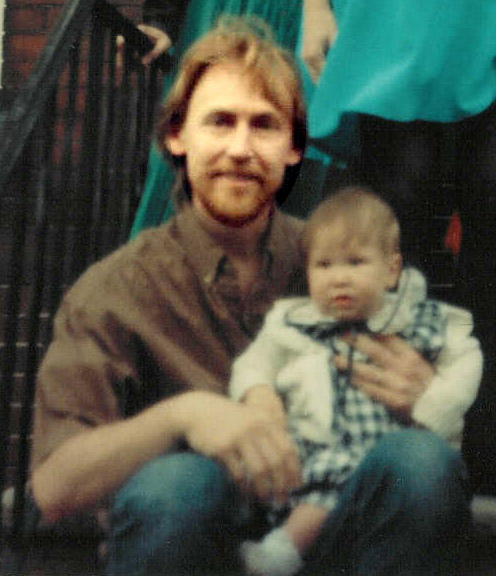
|
| Jeff Webster and Arden |
They had come up with their name by now. Mary, with a typical New York sense of fashion, wore several cheap earrings at once. Quantity over quality, she laughed. One was a crucifix, the other was a little green plastic mermaid from a Sonic cup that she wore upside down. Alan commented on it, and the name was born. The band was knocking out songs on a regular basis now, and even doing some gigs. The live shows were more performance art than music, since they all knew they didn't play well enough to embarrass themselves in public. So it was taped music, live vocals, video tape and performance. It's safe to say, they didnt make a hit on the live circuit. "We played mostly performance type clubs - Ellie at Dixon Place even had us do more than one show. The last gig we did was there. We had live guitar courtesy of Jeff Webster of the Wooster Group, who had played on the second cover song we did. It was a Spaghetti-Western theme from an Italian gladiator movie called 'The Mighty Sons of Hercules.' The live performance was a disaster. Nobody smiled during the entire thing, even when we did 'Adolf.' It was so bad we never did another gig. Though someone tapped it for us, and it doesn't look half as bad as it felt up on stage."

|
| Paula Gordon |
By this time, Mermaid was actually getting airplay. Paula Gordon, a Wooster Group technician, was DJing at WFMU, a college radio station out of West Orange, New Jersey. It was about the only college radio station you could get in the city. She had a shift in the wee hours and played some of their music. "Paula told me one of the other DJs had asked her what label we were on," said Alan. "We both got a good laugh out of that."
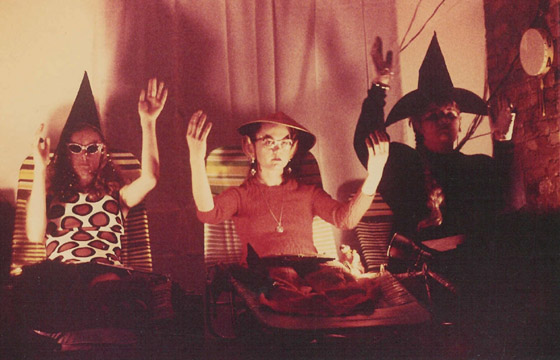
|
| Sue, Mary and Coco in "Magical Thinking" |
They kept recording and doing projects other than live shows. Mary parlayed grant-writing skills learned from the Wooster Group into money. "I turned Magical Thinking from a film into a performance piece. Susan and I and another Wooster intern, Coco McPherson, performed the whole piece sitting in lawn chairs. We even did a dance with them. Each of us came up with found text or our own monologues and the movie ran as a backdrop. The centerpiece was the Samuel Beckett play, 'Come and Go.' We disregarded all of Beckett's stage directions. Alan ended up playing Dr. Barbie, our psychiatrist. He didn't say much, but he got to stuff a fish into a high heeled shoe and do the drunken monkey dance and we all sang 'Adolf in the Morning' at the end. We took it to the Edinburgh Fringe Festival after New York. We had a lot of fun, got some good reviews, and got to sleep under covers in August in Edinburgh instead of sweltering in New York.". Sue agreed - "There was some cool group from the U.K. called the Mutoid Wastes who paraded through the streets in scrap metal salvage tanks, like something out of The Road Warrior, and another group from Eastern Europe called, "Tatoo" who performed a piece with striking beauty, intelligence and sensitivity. And then there was us, representing the "kulchah" of the States, performing in backyard aluminum lawn chairs, mocking one of the most reknowned European playwrights of the last century. We aligned closely with some Scottish group using a rotting sheep's carcass in their show, and had ourselves a nasty little bar-b-que at the end of the run. It was a helluva good time."
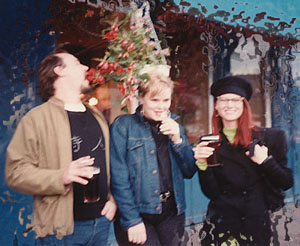
|
| Al, Coco and Mary enjoy local brew and flora. |
After Edinburgh, Mary and Alan went with Coco to the Isle of Arran. Here Alan spent one evening with a radio/tape cassette deck plucking sounds from the northern aether. "I'd just run the tuner up and down until I found something interesting. A lot of static, jumbled radio music, World Cup scores, the Armed Forces Network and some Commie news broadcast. I already had a copy of a tape the Buttholes had of one of the offshore English stations. It was a mock interview of a guy that did gay music from the industrial north. The interview was hilarious, talking about all the French poufs from London and that the mine pits were where all the real gays were, and had been since the industrial revolution. I did another heroin dance song that used that for text. I always wanted to give it to Ginsberg to see what he thought, but I never got around to it."
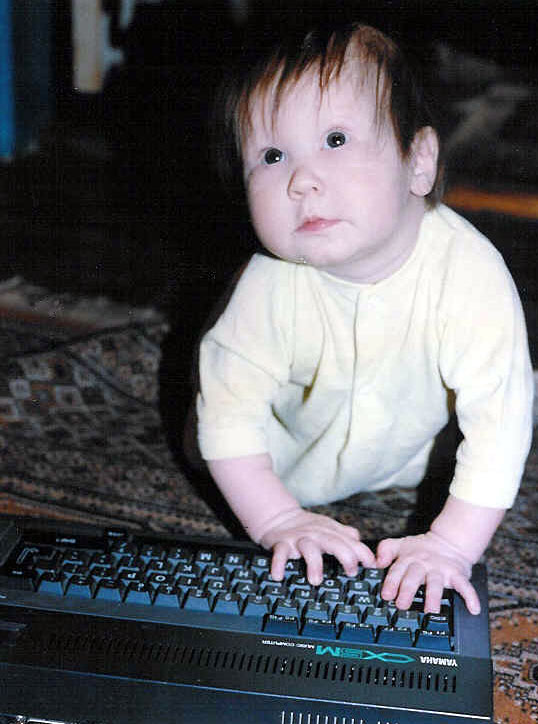
|
| Arden tries out the CX5M |
Alan had added a computer to his rig, the Yamaha CX5M, which came with a sequencing program and had FM synthesis built in. "It was the best computer in the mid 80s for doing music. It let you program FM voices. It only had 4 operators, instead of 6 like the DX-7, but you could tweak them on screen. I bought another one after they got cheap, since it didn't have the processing power to sequence and do FM at once. I got some great evolving, clangorous sounds out of it for 'Snakepit,' and it could make good organ sounds. With the sequencer and drum machine I could get the rhythm section of the songs down without going to tape. Then I could lay down the drums and multiple synths onto 4 tracks at once on the Tascam. That left 4 tracks for vocals etc. without having to submix anything. And my writing was getting more complex. On 'Tongue and Marrow' I put in a change up at the end of each section, kind of a Spanish sounding brass. The lyrics were weird, spoken in sync by Susan and me. Half the stanzas were written by me and the alternating halves by Gayle Ehrenman, another Brooklyn grad poet. And Mary brought in a couple of people to do a chorus part, which added a lot to an interesting song."
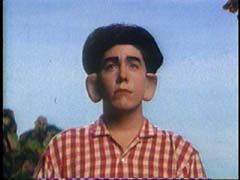
|
| Todd Adams as Davey in "He Was Once" |
Another one of Mary's projects was the film "He Was Once," produced by Apparatus, a company started by some ex-Brown students. The company included Todd Haynes and Christine Vachon, both of whom would soon be leaders in the indie film world. They produced the film (Todd even appeared in a bit part) which was a big hit on the indie circuit and won a lot of awards. Mary, "It even showed at the USA Film Festival in Dallas, so my parents and all the people back home got to see it." Once again Art Clokey provided the inspiration. The story - based on a real incident from Alan's childhood - ran like a twisted variation of a Davey and Goliath episode, with the Father beating Davey until he confessed that an outrageous-but-true anectdote was a lie he had made up. "We had everyone in big plastic wigs and the actors moved in slow motion while the camera ran at half-speed. It gave a claymation feel to live action." Alan and Mary did the music and a lot of the sound effects. The end title song recalls old science fiction soundtracks. In fact, everyone in Mermaid was moving to film. Susan, who had been in "He Was Once," was pounding the pavement for acting jobs looking for more work now that she was out of school.
Alan also started getting work in the movies. "I worked on a script that paid the rent for a while. Then I ran into Kjehl Rasmussen, a high school friend, on the street in the East Village. He was in town finishing a Miramax movie, 'Animal Behavior.' He came over to my place and saw all the music equipment. I ended up producing some stuff for the movie and got credit as a musical consultant. A couple of years later I was up in Maine with some of the musicians I used and we found it in the video rack at the local 7-11. On Kjehl's next movie I got a writing credit. It was a horrible story about horse racing, but it was already shot and in the can. Kjehl had bought the footage from a failed savings and loan, cut it and we shot some newsroom footage to make sense out of the new storyline. 'Winning Colors' ended up showing in South America."
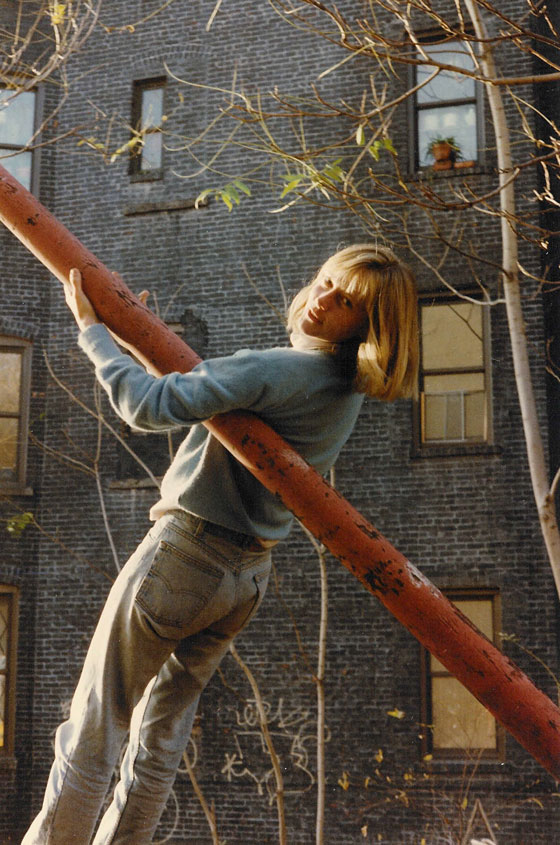
|
| Sue in the boat on E. 8th St. |
As the eighties rolled to a close, so did Mermaid. Mary went back to Texas for six months, leaving Susan and Alan to carry on. This only produced two more songs, but they were good ones. "Leather Weasel" ended up sounding a lot poppier than most of Mermaid's other songs. "That is probably the most song-like number I ever wrote. I had come up with the basic rhythm and ended up using it for finger practice for years before I put it onto tape. It's about 20 bars long. I got an echo on the drums to sit in the back pocket of the beat so it is doubled. Susan wrote the vocals and sang them. We got two good takes of her and left both up on the mixdown. Her timing is a little off, so they slide around against each other, but in a nice way."
The other song they did was "Edelweiss." "That might be my favorite song that I ever wrote. It's more rock and roll, with a sharp organ part and pounding bass. The middle section was a slow thing on the Siel with the strings -another part I had been fingering for exercise for years. We picked a bunch of words out of a German dictionary and Susan strung them together with a faux German accent. The story seems to be some Nazi wanting the good old days back, but with lines like 'Our country is kaput, but Octoberfest, is good,' it's on the far end of satire. I added a recording of a Hitler speech and at the end of it all Peter Sellers from 'Dr. Strangelove' shouting, 'Mein Fürer, I can walk.'"
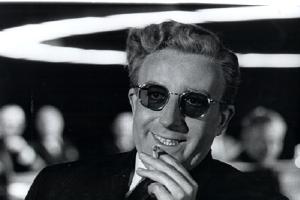
|
| Dr. Strangelove |
Susan was making preparations to go to L.A. to pursue her acting career when Mary came back to New York. In January of 1990 Mary and Alan got married. Susan was the official witness at the City Hall ceremony and, within a few months, had moved out of the Big Apple to the City of Angels. The Mermaids had one last song left in them, however. Susan bought a cassette mini-deck and had the old Casio from Alan. She sent him a couple of songs on tape. Alan, "One song had yodeling on it. I wish I could find it now. The other song became 'PsychicPhque.' For once I didn't have to do the rhythm tracks -- Sue had done it on the Casio. Very cheesy, but it worked. I added drums, timpani synth, some noises and a bluggle bed. Bluggles are plastic tubes that you swing around your head, and they make noise. Kind of like a kitschy bullroarer."
Meanwhile, Mary and Alan had a daughter, and Mary was pregnant with another one. They had outgrown 8th Street, which was basically a one bedroom ground floor. "We turned the one bedroom into two, which meant both were just big enough for a futon and chest of drawers. Obviously we couldn't get another bedroom out of it. Rents had continued to skyrocket so we couldn't afford to stay in the city and couldn't really afford a big enough place in the boroughs, either. We had decided to move back to Texas as soon as our oldest was ready for school." It was at this point that Alan had a shooting accident, which moved the timetable up a few years. "The last place I lived in NYC was St. Vincents hospital. I did my rehab in Texas."
In Dallas, Alan and Mary didn't have time for much music. And after rehabilitating his right arm, Alan proceeded to break both his wrists jumping over the back fence when he was locked out of the front door. That put a crimp in any keyboard playing.
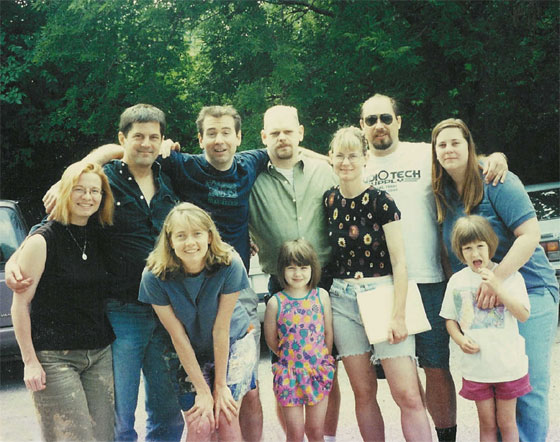
|
| Sue and the re-patriated Texas gang |
So the Mermaids died with a bang after a simmering whimper. Susan quickly established herself in Hollywood. She got a part on the television series "Parenthood," a spinoff of the movie. She did a couple of TV movies, one staring opposite every German's favorite actor, David Hasselhoff, in "Nightrider 2000." And she appeared in two of Todd Haynes movies, "Poison" and "Safe." After a few years she got married and decided to leave the rat-race of California for Seattle, where she now works for the evil empire at Microsoft. She keeps in touch with her old buddies and ventures down south once a year for some real Mexican food and hiking in the hill country.
Mary and Alan have recently started doing music again. He explains, "I finally got a studio set up in our new house. I've still got the old analog equipment, but most of the recording is done on computer now. Once I got a CD recorder, I decided to transfer the old master tapes to archive. That got me in the mood to do more recording. The Siel needed a lot of maintenance and was long in the tooth, so I decided to get a new axe. I got a discontinued Ensoniq FIZMO when they blew them out, which is a really cool keyboard. It uses wavetable synthesis, like the old PPG or the Waldorf. And it has knobs; Im glad to see those coming back. I spent a lot of time getting the computer tweaked and learning Cakewalk , Vegas and Sound Forge. All the programs were easy to learn, which was good, as I had a lot of problems getting everything to work right with the computer. I know more about them now than I ever wanted to - just enough to get myself into trouble and half out. I feel like I spend more time doing tech stuff rather than creating."
So far they have finished four new songs. The first was "The Ballad of Little Juan." It is classic Mermaid psycho-pop. Except they don't go under the nom de music of X and the Mermaid '69 anymore. "I've got reams of names and factoids in my daybook. It came down to Room 101, Joystick and Squawk Box. I polled the girls and ended up using Room 101. It's from Orwell's 1984 - the room that contains every individuals worst fear."
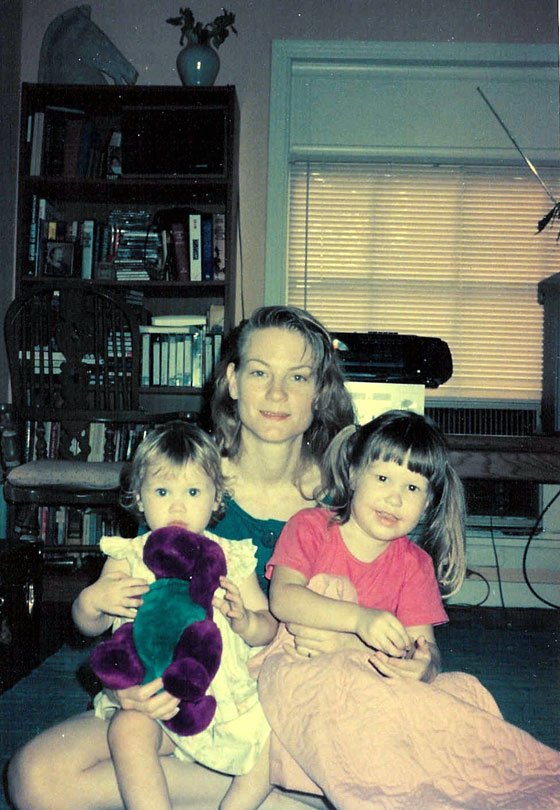
|
| Mary with Davey and Little Juan |
"Little Juan" is based on a story made infamous in the NY Post about a boy who snuck into the Bronx Zoo. After telling his friend that the only thing polar bears are more scarred of than water are people, Juan was quickly eaten when he jumped into the animals' habitat. Mary and Alan's two oldest children play Juan and friend (Davey, in another homage to Clokey) in the middle section. Mary sings the set up. Alan describes the process, "When I was writing the middle section for Arden and Arran, I needed a name. Davey sprang to mind, and then Goliath's ubiquitous warning, 'Gee Davey, I dont know.' Juan gets to say it as his friend, the only witness, eggs him on into the polar bears. Which is opposite of how his friend described the situation to the police as reported in the paper. Adds a little twist. As the chorus says, 'Little Juan wasnt too bright.'"
"Horrorshow" sounds like a Hitchcock soundtrack. There are no drums, but a pounding beat on the FISMO accented by tremolo strings, bells and the Moog doing a theremin imitation a la Portishead. The text is very thick, with Mary singing a collage of Kim Novak's lines in "Vertigo" about how people die but the trees live on, Peter Lorre shrieking in German from "M," and strange messages saved from the answering machine.
"Lemonade" is Alan's favorite of the new songs. "The FIZMO syncs to the midi tempo, and I got it throbbing at 4/4. That is the main sound source and something I could never get with the analog studio. The timbre changes in sync with the beat. And over the top of all of it, Mary did a great job of singing. It was after 9/11 and I wrote a paean to 8th Street, Tompkins Square Park and a girl once again trying to make love more difficult than it has to be. Mary would practice to a tape in the car and our girls would giggle when she'd sing 'polishing a turd.' That was going to be the title, but Mary nixed it, so I added a line about life handing you lemons - hence the new title."
Finally another psycho-pop song, "Registered." "That's a pretty traditional structured song - very bouncy. I was trying to write a more rock-type thing with descending notes and it came out sounding more poppy. It starts with an arpeggiated FIZMO bit and builds up from that. I use the same notes for all my parts, so Mary added a counterpart bass on electric piano sound that twists the song around. And she sings the lyrics, of course, which is some pretty warped stuff about shooting drugs. It could almost be top forty unless you listen to the lyrics."
Alan collected the best of the Mermaid songs and put out a CD called "The Apocryphal Proverb of Christ and the Mermaid '69." "I'll redo three or four of the old ones and add some new ones to put out a new CD. Ive already got a title for it, 'Welcome to Dallas, Mr. President, sic semper tyrannis.' (The Latin is John Wilkes Booth's most famous line, translated as "thus always to tyrants" -Ed.) More details are on the Room101 web site."
Sic semper, Mermaids.

|
